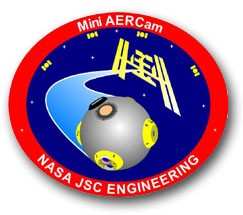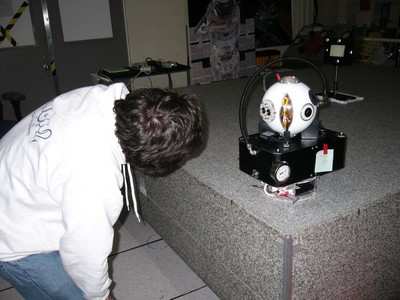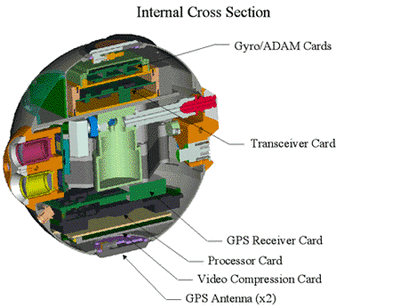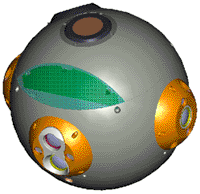NASA Demonstrates Nanosatellite System
 Big things can come in small
packages, and engineers at NASA's Johnson Space Center are making
progress on a tiny spacecraft that holds major promise for future
exploration.
Big things can come in small
packages, and engineers at NASA's Johnson Space Center are making
progress on a tiny spacecraft that holds major promise for future
exploration.
Work on the volleyball-sized Miniature Autonomous Extravehicular
Robotic Camera (Mini AERCam) moved forward with successful initial
tests on its docking system. The Mini AERCam is designed to help
astronauts and ground crews see outside the spacecraft during a
mission. During ground-based testing, the device was able to work
with the docking system that serves as an exterior home base for
housing and refueling the nanosatellite.
Since early 2000, NASA engineers have been working to create a
miniaturized spacecraft that can be deployed from a parent vehicle
to inspect the exterior or provide remote-controlled views during
space operations. Early development is funded by the Space Shuttle
Program Office, which is considering using Mini AERCam to inspect
the Shuttle's heat shield in space. The nanosatellite will not be
used on the Return to Flight mission (STS-114), but holds long-term
promise for future space operations.

The Mini AERCam could provide beneficial on-orbit views that
cannot be obtained from fixed cameras, cameras on robotic
manipulators, or cameras carried by space-walking crewmembers. For
Shuttle or International Space Station missions, Mini AERCam could
support external robotic operations by supplying situational
awareness views to operators, supplying views of spacewalk
operations to flight and/or ground crews, and carrying out
independent visual inspections.
Free-flying spacecraft such as Mini AERCam will be particularly
critical for external inspections during long-duration missions, as
spacewalks will be kept to a minimum and external camera views may
be limited.
The Mini AERCam prototype is just 7.5 inches in diameter and
weighs only 10 pounds. The tiny free flyer is designed to be
operated by on-orbit flight crews or by ground control personnel.
Either could command the nanosatellite to fly automatic
maneuvers.

Mini AERCam could be deployed and retrieved many times during a
single space mission, with the use of a hangar-based docking system
located on the exterior of the vehicle. The free-flyer portion of
the docking system includes a vision-based system for autonomous
navigation and an electromagnetic capture capability. The docking
culminates in a precision hard-dock, suitable for connecting
propulsion and electrical recharge elements. The docking capability
has been demonstrated both on an air-bearing table and in orbital
simulation environments.
 For human spaceflights, automatic
deployment and docking eliminates the need for astronauts to
perform a spacewalk to release and retrieve the free flyer. For
robotic missions, external basing is essential. The docking system
provides a protective base during periods it is not needed for
mission operations.
For human spaceflights, automatic
deployment and docking eliminates the need for astronauts to
perform a spacewalk to release and retrieve the free flyer. For
robotic missions, external basing is essential. The docking system
provides a protective base during periods it is not needed for
mission operations.
Mini AERCam incorporates significant upgrades in a package that
is one-fifth the volume of its precursor, the 35-pound, 14-inch
AERCam Sprint. It flew as a Space Shuttle flight experiment on
STS-87 in 1997. Upgrades include a full suite of miniaturized
avionics, instrumentation, digital imagers, communications,
navigation, video, power and propulsion subsystems.
Technology innovations include rechargeable xenon gas
propulsion, a rechargeable lithium ion battery, custom avionics
based on the PowerPC 740/750 microprocessor, "camera-on-a-chip"
imagers with video compression, micro electromechanical system
gyroscopes, precise relative GPS navigation, digital radio
frequency communications, micro-patch antennas, digital
instrumentation networking and compact mechanical packaging.
 Classic Aero-TV: Up Close And Personal - The Aeroshell Aerobatic Team at Oshkosh
Classic Aero-TV: Up Close And Personal - The Aeroshell Aerobatic Team at Oshkosh ANN's Daily Aero-Term (07.13.25): Tactical Air Navigation (TACAN)
ANN's Daily Aero-Term (07.13.25): Tactical Air Navigation (TACAN) ANN's Daily Aero-Linx (07.13.25)
ANN's Daily Aero-Linx (07.13.25) NTSB Prelim: Pitts S2
NTSB Prelim: Pitts S2 Airborne 07.09.25: B-17 Sentimental Journey, Airport Scandal, NORAD Intercepts
Airborne 07.09.25: B-17 Sentimental Journey, Airport Scandal, NORAD Intercepts






